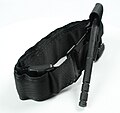Emergency tourniquet
Emergency Tourniquet
An emergency tourniquet is a medical device used to control blood loss in traumatic injuries, particularly those affecting the limbs. It works by applying pressure to the affected area, thereby restricting blood flow and preventing further blood loss until medical help can be obtained.
History[edit]
The use of tourniquets dates back to the times of Ancient Greece, where they were used in surgical procedures. The modern emergency tourniquet, however, was developed during the World War I, where it was used to control bleeding in wounded soldiers on the battlefield.
Types of Emergency Tourniquets[edit]
There are several types of emergency tourniquets, including:
- Mechanical Tourniquets: These are typically used in surgical procedures. They consist of a cuff that is placed around the limb and inflated to apply pressure.
- Manual Tourniquets: These are often used in emergency situations. They can be made from a variety of materials, such as cloth or rubber, and are tightened around the limb using a stick or similar object.
- Pneumatic Tourniquets: These are similar to mechanical tourniquets, but use air pressure to apply the necessary pressure.
Usage[edit]
Emergency tourniquets are used in a variety of situations, including:
- Trauma Care: They are commonly used in trauma care to control bleeding in patients with severe injuries.
- Military Medicine: In the military, tourniquets are often used in battlefield situations to control bleeding in wounded soldiers.
- Outdoor Survival: In outdoor survival situations, a tourniquet can be a lifesaving tool if a person is injured and bleeding heavily.
Risks and Complications[edit]
While emergency tourniquets can be lifesaving, they also carry risks and potential complications. These include nerve damage, tissue death, and in extreme cases, loss of the limb. Therefore, they should only be used when absolutely necessary and should be applied by a trained professional whenever possible.
See Also[edit]
This emergency medicine related article is a stub. You can help WikiMD by expanding it.
-
Improvised tourniquet
-
Tourniquet
-
EMT Emergency & Military Tourniquet
-
Tourniquet application
-
Demonstrating the proper use of a tourniquet
Ad. Transform your life with W8MD's Budget GLP-1 injections from $75


W8MD offers a medical weight loss program to lose weight in Philadelphia. Our physician-supervised medical weight loss provides:
- Weight loss injections in NYC (generic and brand names):
- Zepbound / Mounjaro, Wegovy / Ozempic, Saxenda
- Most insurances accepted or discounted self-pay rates. We will obtain insurance prior authorizations if needed.
- Generic GLP1 weight loss injections from $75 for the starting dose.
- Also offer prescription weight loss medications including Phentermine, Qsymia, Diethylpropion, Contrave etc.
NYC weight loss doctor appointmentsNYC weight loss doctor appointments
Start your NYC weight loss journey today at our NYC medical weight loss and Philadelphia medical weight loss clinics.
- Call 718-946-5500 to lose weight in NYC or for medical weight loss in Philadelphia 215-676-2334.
- Tags:NYC medical weight loss, Philadelphia lose weight Zepbound NYC, Budget GLP1 weight loss injections, Wegovy Philadelphia, Wegovy NYC, Philadelphia medical weight loss, Brookly weight loss and Wegovy NYC
|
WikiMD's Wellness Encyclopedia |
| Let Food Be Thy Medicine Medicine Thy Food - Hippocrates |
Medical Disclaimer: WikiMD is not a substitute for professional medical advice. The information on WikiMD is provided as an information resource only, may be incorrect, outdated or misleading, and is not to be used or relied on for any diagnostic or treatment purposes. Please consult your health care provider before making any healthcare decisions or for guidance about a specific medical condition. WikiMD expressly disclaims responsibility, and shall have no liability, for any damages, loss, injury, or liability whatsoever suffered as a result of your reliance on the information contained in this site. By visiting this site you agree to the foregoing terms and conditions, which may from time to time be changed or supplemented by WikiMD. If you do not agree to the foregoing terms and conditions, you should not enter or use this site. See full disclaimer.
Credits:Most images are courtesy of Wikimedia commons, and templates, categories Wikipedia, licensed under CC BY SA or similar.
Translate this page: - East Asian
中文,
日本,
한국어,
South Asian
हिन्दी,
தமிழ்,
తెలుగు,
Urdu,
ಕನ್ನಡ,
Southeast Asian
Indonesian,
Vietnamese,
Thai,
မြန်မာဘာသာ,
বাংলা
European
español,
Deutsch,
français,
Greek,
português do Brasil,
polski,
română,
русский,
Nederlands,
norsk,
svenska,
suomi,
Italian
Middle Eastern & African
عربى,
Turkish,
Persian,
Hebrew,
Afrikaans,
isiZulu,
Kiswahili,
Other
Bulgarian,
Hungarian,
Czech,
Swedish,
മലയാളം,
मराठी,
ਪੰਜਾਬੀ,
ગુજરાતી,
Portuguese,
Ukrainian





